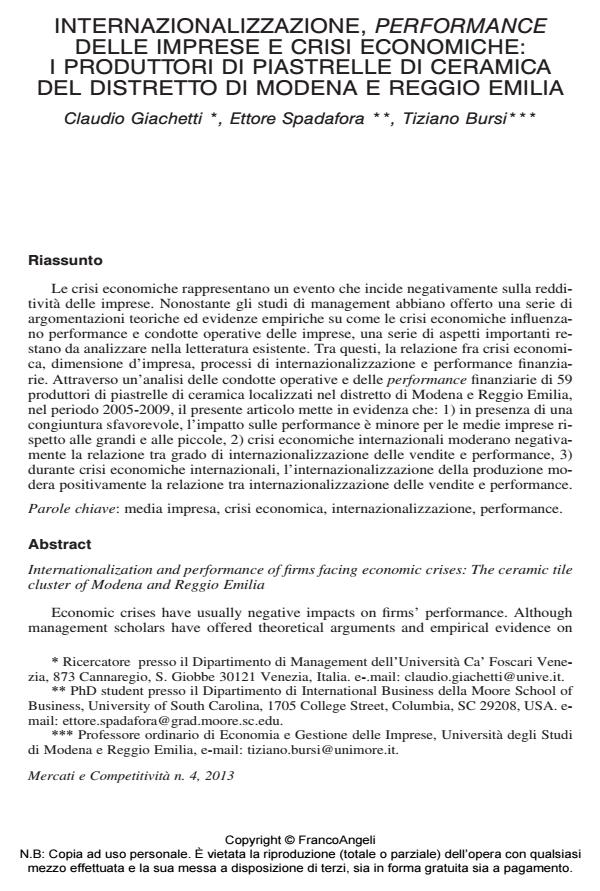Internazionalizzazione, performance delle imprese e crisi economiche: i produttori di piastrelle di ceramica del distretto di Modena e Reggio Emilia
Titolo Rivista MERCATI E COMPETITIVITÀ
Autori/Curatori Claudio Giachetti, Ettore Spadafora, Tiziano Bursi
Anno di pubblicazione 2013 Fascicolo 2013/4
Lingua Italiano Numero pagine 22 P. 37-58 Dimensione file 540 KB
DOI 10.3280/MC2013-004003
Il DOI è il codice a barre della proprietà intellettuale: per saperne di più
clicca qui
Qui sotto puoi vedere in anteprima la prima pagina di questo articolo.
Se questo articolo ti interessa, lo puoi acquistare (e scaricare in formato pdf) seguendo le facili indicazioni per acquistare il download credit. Acquista Download Credits per scaricare questo Articolo in formato PDF

FrancoAngeli è membro della Publishers International Linking Association, Inc (PILA)associazione indipendente e non profit per facilitare (attraverso i servizi tecnologici implementati da CrossRef.org) l’accesso degli studiosi ai contenuti digitali nelle pubblicazioni professionali e scientifiche
Le crisi economiche rappresentano un evento che incide negativamente sulla redditività delle imprese. Nonostante gli studi di management abbiano offerto una serie di argomentazioni teoriche ed evidenze empiriche su come le crisi economiche influenzano performance e condotte operative delle imprese, una serie di aspetti importanti restano da analizzare nella letteratura esistente. Tra questi, la relazione fra crisi economica, dimensione d’impresa, processi di internazionalizzazione e performance finanziarie. Attraverso un’analisi delle condotte operative e delle performance finanziarie di 59 produttori di piastrelle di ceramica localizzati nel distretto di Modena e Reggio Emilia, nel periodo 2005-2009, il presente articolo mette in evidenza che: 1) in presenza di una congiuntura sfavorevole, l’impatto sulle performance è minore per le medie imprese rispetto alle grandi e alle piccole, 2) crisi economiche internazionali moderano negativamente la relazione tra grado di internazionalizzazione delle vendite e performance, 3) durante crisi economiche internazionali, l’internazionalizzazione della produzione modera positivamente la relazione tra internazionalizzazione delle vendite e performance.
Parole chiave:Media impresa, crisi economica, internazionalizzazione, performance
- Gli strumenti di misurazione delle strategie di content marketing: un confronto tra imprese italiane e inglesi Niccolò Gordini, Elisa Rancati, in MERCATI E COMPETITIVITÀ 1/2015 pp.45
DOI: 10.3280/MC2015-001004 - Effects of cultural distance on foreign acquisitions: evidence from italian acquired firms Michela Matarazzo, Gabriele Barbaresco, Resciniti Riccardo, in MERCATI & COMPETITIVITÀ 3/2016 pp.159
DOI: 10.3280/MC2016-003009
Claudio Giachetti, Ettore Spadafora, Tiziano Bursi, Internazionalizzazione, performance delle imprese e crisi economiche: i produttori di piastrelle di ceramica del distretto di Modena e Reggio Emilia in "MERCATI E COMPETITIVITÀ" 4/2013, pp 37-58, DOI: 10.3280/MC2013-004003